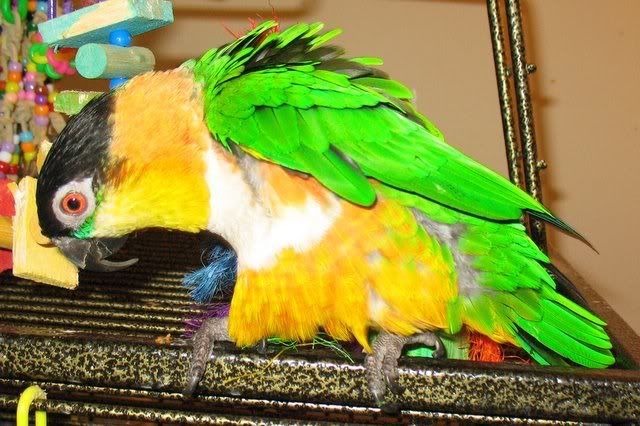Before I get too far in, let me restate that I certainly don't consider myself a parrot expert! Additionally, there is so much that we don't know when it comes to making these guys as happy as we could. On many topics (for example: feeding pellets, clipping vs. allowing flight, giving boxes as toys) one can make coherent arguments for both sides. My practice has been to try to gather as much information and as many opinions as I can on keeping parrots. Then, I combine that information with common sense and my own experiences when interacting with them, always reserving the right to change course when new information or experiences arise! Also, what works for one household will not necessarily work for another, and what works for one bird may not work for another birds in that same house.
About four years ago, we were living with Max and our cage-bound elderly budgie, Lenny. I don't think Max recognized Lenny as another bird (he was terrified of people and hated coming out of his cage). She certainly wasn't jealous of him as 99% of the attention was focused on her. I basically considered us a one-bird family at this point. I say this with no disrespect for Lenny. We loved him and provided him the best life we could and were devastated when he died.
Thomas and I had many discussions about whether we should add a new parrot to our house, what kind, etc. We hadn't made up our minds when a black-headed caique was surrendered to the rescue where we volunteer. His name was Calypso, and he was captivating. The first thing he did when Thomas removed him from the carrier his previous owner had transported him in to surrender him was climb up Thomas's arm and bite him on the ear. An auspicious beginning!
We'd interact with Calypso during our twice-weekly visits to the rescue. There wasn't much interest in him by potential adopters as he didn't want to come out of his cage and wasn't friendly when he was forced out. He came to like us, though, and after maybe 6 weeks of this, we decided to take him home.
A picture of Calypso from September 2007:
Surfing the Internet for guidance, I found this article, and it made a lasting impression on me. Concepts in this article are how we introduced Calypso, and then 5 others into our house (Ethel, Daphne, Rocky, Beeps, Jeff Saturday). They shape interactions we have with our parrots every single day.
Basically, we run our house on the concept of "First Among Equals." Our current 5 birds came into our lives in this order: Max, Calypso, Daphne, Rocky, Beeps. That's the order in which they get fed, come out of their cages, go to bed (in reverse order), do clicker training sessions.
We've found that this method helps with structure and routine (which parrots love). It also allows us to reaffirm to Max on a daily basis that she is well-loved and that no one is going to replace her in our lives.
When it's not carried out, we hear about it from the birds! A couple of examples:
I'm usually the one who distributes their seeds in the evening, and I distribute in this order: Max, Calypso, Rocky, Beeps (Daphne doesn't get additional evening seeds). A few months ago, Thomas distributed the seeds. However, Max and the caiques were in the kitchen and Rocky was on his cage making begging sounds, so Thomas gave Rocky his bowl first and then placed the seed dishes on the other 3 empty cages. The routine had been altered! The next day, when I once again fed, Rocky was making begging sounds, but I told him to wait his turn and he would get his food in 5 seconds. Because he didn't know what to expect -- he had been fed first yesterday, after all -- he started screaming when I gave Max her seeds first. It took me a week or so until he realized that the routine was back in force and that screaming wouldn't get him fed any sooner.
The second story relates to our last vacation. I had neglected to tell our friend who comes over to watch the animals when we're gone about the importance of First Among Equals. For the first part of the week, she let Max out first, and then the other birds. Then, one day, she let Rocky out first. Max refused to come out of her cage. When she finally emerged, she didn't follow our friend into the kitchen as she had on the previous days, didn't make any sounds, and was generally ill-tempered. Our friend was seriously considering taking her to the vet because of the drastic changes in her personality. The next day, Max was let out first again, and her normal demeanor returned. Upon our return, my friend asked me about this. I explained First Among Equals and apologized for forgetting to tell her about it ahead of time!
What I like about this is that everyone knows where they stand, especially where food and coming out of the cage are concerned! Max, the only one who knows what it's like to have Thomas and me to herself, still gets some special privileges. For example, after putting everyone else to bed, I take her in the bathroom with me as I brush my teeth for some final one-on-one time.
I realize this may not work for everyone, but it's what we've been doing to (more or less) successfully keep harmony in our multi-bird home!


No comments:
Post a Comment